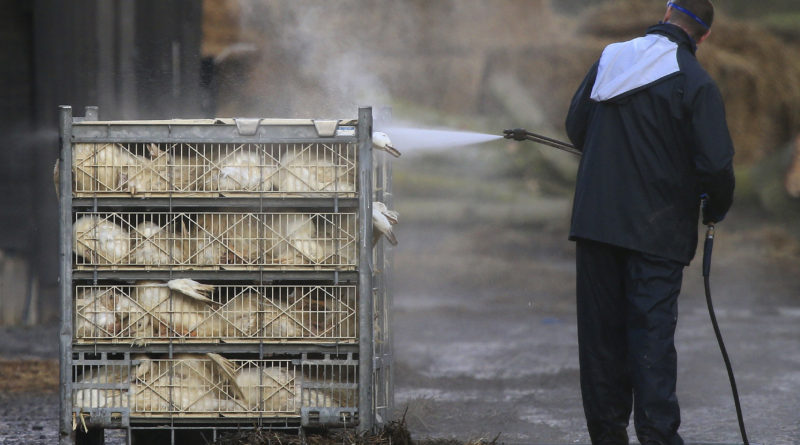Mankind Under Threat
Human beings are vulnerable to various infectious diseases or zoonoses, which are transmitted from animals. Here we present an in-depth study of these deadly infections, the strategies for their prevention and their possible cures
By Dr Suneela Garg & Dr Neha Dahiya


Zoonoses is defined as an infection or infectious disease transmissible under natural conditions from vertebrate animal to man. Based on the direction of transmission these are classified as Anthropozoonoses, which are infections transmitted from animals to man for example rabies, plague, etc. Zooanthroponoses are infections, which are transmitted from man to animals for example human T.B. in cattle and amphixenosis are infections, which are transmitted in either direction between animals and man for example tryanosoma cruzi and schistosoma japonicum.
Humans have enjoyed a long and intimate relationship with other animals. Some animals are reared to provide food, milk or clothing and some for recreational purposes which predisposes to zoonotic disease. Zoonoses of public health importance are rabies, yellow fever, Kyasanur Forest Disease, Japanese encephalitis, Brucellosis, Salmonelliasis, Taeniasis, Leishmaniasis, and Hydatid Disease.
Rabies
Rabies is a dead end infection in man caused by lyssavirus type1. There are two types of rabies virus: street virus and fixed virus. Incubation period is 3-8 weeks and it depends on severity of wound and infection. Mode of transmission of virus is from rabid animal bite (dogs, cat, monkeys), licks on abraded skin and mucosa. Its movement from person to person is rare but possible.
Wild Animals==>Dogs, cat, monkeys==>Man
Human attraction to recreational activates in wildlife also contributes to the increased prevalence of the disease. Initial signs and symptoms of rabies are nonspecific such as fever and headache but as the infection progress it causes inflammation of brain and meninges, paralysis, anxiety, insomnia, confusion, paranoia, hallucinations progressing to delirium and coma. Prevention strategies for rabies includes wound management and anti rabies vaccine which are available for intradermal and intramuscular use (Essen regimen for intramuscular use Day 0,3,7,14,28; purified chick embryo cell vaccine Rabipur and updated thai regimen for intradermal use on Day 0,3,7, 28 purified vero cell rabies vaccine Verorab and Abhayrab) and for pre exposure prophylaxis on day 0,7,21/28. Anti-rabies serum such as horse anti-rabies serum and human rabies immunoglobulin are used in case of category 3 wound management. Another approach for rabies prevention is immunization of dogs. Primary immunization at 3-4 months and boosters at regular intervals. Most cost effective approach for control of urban rabies is elimination of stray dogs and mass immunization of dogs of an area; at least 80% of entire dog population of an area must be immunized.
Japanese Encephalitis
Japanese Encephalitis is caused by group B arbvovirus. In India, the disease is endemic in 18 states – Assam, Bihar, Haryana, Uttar Pradesh, Karnataka, West Bengal and Tamil Nadu report its outbreak every year and contribute to 80% of cases and deaths.
PIG==>MOSQUITO==>PIG
ARDEID BIRD ==>MOSQUITO ==>ARDEID BIRD
Pigs themselves do not manifest overt symptoms but circulate the virus. Horses are only domestic animals which show signs of encephalitis due to JE virus. Birds such as pond herons, cattle, poultry and ducks are also involved in natural history. Vectors are the culicine mosquitoes. Incubation period of Japanese encephalitis in man is 5-15 days and majority of infections are asymptomatic. Fever, headache and malaise are the nonspecific symptoms which last for 1-6 days. It causes acute encephalitis stage which is characterized by neck rigidity, cachexia, hemiparesis, convulsions and raised body temperature. Lifelong neurological defects such as deafness, emotional ability and hemiparesis may occur in those individuals who had central nervous system involvement. 85% of cases occur in children < 15 years of age. Prevention of Japanese encephalitis is done by vaccination with single dose of live attenuated vaccine (SA14-14-2), followed by single booster given at an interval of 1 year. Now this vaccine is also given in endemic states as a part of universal immunization programme. It also necessitates vector control by aerial and ground fogging with ultra low volume insecticides. The spraying should cover the vegetation around the houses, breeding sites and animals shelters in the affected villages. The use of mosquito nets should be advocated.
Kyasanur Forest disease
Kyasanur Forest disease is also known as monkey disease. Causative agent is group B togavirus. Rats and squirrels act as a reservoir of infection and pigs as amplifier hosts.
Rats and Squirrels==>Ticks Cattle==>Man
Man is an incidental dead end host. The symptoms of the disease include high fever with frontal headaches, hemorrhagic symptoms such as bleeding from throat and gums, vomiting, muscle stiffness, tremors and absent reflexes. In India hard tick acts a vector of KFD. Prevention of Kyasanur Forest disease is done by control of ticks, restriction of cattle movement, vaccination and personal protection through repellants.
Salmonellosis
Animals==>Man==>Animal
Salmonellosis is one of the most common and widely distributed food borne diseases and is caused by the bacteria salmonella. Human salmonellosis represents 60-80% of all reported cases of food borne diseases. Salmonella typhimurium, S enteritidis can infect both man and animals. The source of infecting agent could be contaminated food (mainly of animal origin), animals like farm animals which may frequently be intestinal carriers of the organisms and because generally no symptoms of disease is observed, these animals pass veterinary slaughter house inspection easily, man or the environment (widely distributed in dust, milk, water, manure, sewage, sludge, vegetation. They can survive in soil for months. Human infections occur when animal products are improperly handled during final preparation which can happen at home or large kitchen of restaurants, hospitals and factories. Once man is infected, he becomes a source and the infections may spread to others by the fecal-oral route. It is usually characterized by acute onset of fever, abdominal pain, diarrhea, nausea and sometimes vomiting. The onset of disease symptoms occurs 6-72 hours (usually 12-36 hours) after ingestion of salmonella, and illness lasts 2-7 days. Since it’s a zoonotic disease preventive measures include the farms, animal products, processing, final food preparation to consumption. Approaches required at farm levels are a) disease control which includes immunization of farm animals against salmonellosis b) use of hygienic animal feed c) sanitary environment for the animals d) hygienic slaughtering and milking, pasteurization of milk and eggs, proper disposal of liquid and solid wastes, cold storage facilities and health education and training.
Leishmaniasis
Leishmaniasis is caused by leishmania donovani, tropica, braziliensis. Dogs, jackals, foxes, rodents and other mammals acts as a reservoir of infections but Indian leishmaniasis is a non zoonotic infection. Man acts as only reservoir and female phlebotamine sandflies which lives in cracks and crevices of walls, tree holes caves acts as vector.
Dogs, Jackals and Rodents ==>Sandflies==>Man
Man==>Sandflies==>Man
This infection is transmitted through bite of female phlebotamine sandflies, contamination of bite wound, crushing of insect while feeding and blood transfusion. Incubation period varies from 10 days to 2 years. The symptoms are skin sores which erupt weeks to months after person bitten by infected sand flies. Cutaneous leishmaniasis is the most common form which also resembles leprosy and may not heal itself. Visceral leishmaniasis or kala azar is the most serious form and causes enlarged spleen and liver. Leishmaniasis is diagnosed through aldehyde test of napier and serological tests such as ELISA, rk39 dipstick test, indirect fluorescent test and direct agglutination test. Leishmaniasis can be prevented by taking appropriate control measures in animal reservoirs for example dogs and rodents. Sandfly control by application of residual insecticide is also a useful measure combined with sanitation measures like elimination of breeding places for example cracks in muds or stone walls, rodents burrow, location of cattle sheds and poultry at a distance from human dwelling. The risk of infection can further be reduced by health education and personal prophylaxis.
Bovine tuberculosis
Bovine tuberculosis is a chronic zoonotic infection in India. It is caused by mycobacterium tuberculosis, M. bovis, M. cosmeticum, M.Bovis is considered as most common in cattle which can be transmitted to man through milk and meat. In bovine after infection nonvascular nodular graulomas known as tubercles may develop. In humans, symptoms are similar to human T.B including weight loss, fever, night sweat and persistent cough. Bovine tuberculosis infection in cattle is usually diagnosed in the live animal on the basis of delayed hypersensitivity reactions. Rapid nucleic acid methodologies such as PCR but traditional mycobacterial culture remain the gold standard method for routine confirmation of infection. Most of the abattoirs in India do not have diagnostic facility. Bovine tuberculosis can be controlled by proper sanitation and vaccination of slaughter bovine. Inspection during postmortem of infected carcasses with bovine tuberculosis lesions in its organs can be rejected but in India such rejection rarely meets in action. The food handlers should also undergo medical examination whether having tuberculosis or not. The frozen buffalo meat should pass through gamma irradiation to kill and form safe production of buffalo meat at abattoir. Therefore, proper implementation of meat inspection procedures during slaughtering with public awareness are important to control bovine tuberculosis in India.
Taeniasis
Taeniasis is caused by taenia saginata and t.solium. The parasite is global in distribution where beef is eaten. Human cysticersosis caused by t.solium is more important public health problem than human taeniasis. It is transmitted through the ingestion of infective cysticerci in undercooked beef or pork, through ingestion of food, water or vegetables contaminated with eggs, reinfection by the transport of eggs from the bowel to the stomach by retroperistalsis.
T. Saginata==>Cattle==>Man
T. Solium==>Pigs==>Man
Incubation period varies from 8 to 14 weeks. Taeniasis is generally asymptomatic and is diagnosed when a portion of the worm is passed in the stool. Heavy infection is indicated by intestinal irritation, anemia, indigestion. It also causes neurocysticerosis which can be fatal. It can be prevented through treatment of infected persons, meat inspection, health education, adequate sewage treatment and disposal. Also required are education of public to prevent pollution of soil, water and food with human faeces and washing of hands before eating and after defecation.
Hydatid disease
Hydatid disease is caused by echinococcus granulosus. The prevalence of disease is high in food animals in India. It is a dog sheep cycle with man as an accident intermediate host. Hydatid disease is an occupational disease of certain groups for example shepherds and their families in endemic areas and shoe makers.
Dog==>Sheep==>Dog
Human infections occur by ingestion of eggs of echinococcus with food, unwashed vegetables or water contaminated with faeces from infected dogs. The disease in humans is manifested as presence of cysts in liver, lung and other organs in the body such as spleen, brain, heart and kidneys. It is prevented through preventing dogs from gaining access to raw offal at slaughter houses and on farms and to dead animals. Also needed are elimination of stray dogs, surveillance of dogs based on periodic stool examination after administration of teanifuge drug and health education of public mainly of butchers, dog owners, animal breeders and shepherds.
Q fever
Q fever is caused by coxiella burnetii. It is only rickettsial disease without any vector. This naturally infects some animals such as goat, sheep and cattle. It is transmitted through inhalation of infected dust, aerosol transmission, direct contact, contaminated food like meat, milk and milk products. The common symptoms include high fever, chills or sweats, cough, chest pain, headache, clay coloured stools, nausea and diarrhea. It is prevented through pasteurization and boiling of milk.
Brucellosis
Brucellosis in humans is known as malta fever or Mediterranean fever. It is a public health problem worldwide. It is endemic where cattle, pigs, goats and sheeps are raised. It is caused by coccobacilli of genus brucella and four species B.melitensis, B abortus, B suis, and B canis. Main reservoir of human infection are cattle, sheep, goats, swine, buffaloes, horses and dogs.
Cattle==>Brucella ==>Man
The infected animals excrete brucella in urine, milk, placenta, uterine and vaginal discharges particularly during birth or abortion and animal may remain infected for life. Farmers, shepherds, butchers and abattoir workers, veterinarians and lab workers are particularly at risk. It is transmitted through contact infection, food-borne infection, unpasteurized milk, undercooked meat and air borne infection. In humans symptoms include continuous or intermittent fever, headache, weakness, chills, joint pains and weight loss. It is prevented through preventing infections in animals by mass case finding and slaughtering animals with full compensation paid to farmers, vaccination of animal by B.abortus strain 19 and hygienic measures like clean sanitary environment for animals, sanitary disposal of urine and faeces, veterinary care of animals and health education to occupational workers. Pasteurization of milk and protective measures to prevent direct contact with infected animals and vaccination for humans B.abortus strain 19-BA is also available.
Avian influenza or bird flu
Avian influenza is caused by influenza virus A which is a zoonotic infection with a natural reservoir almost entirely in birds. It strains are divided into two types based on pathogenecity high pathogenicity or low pathogeneicity. The most well-known HPAI strain H5N1 appeared in China in 1996. It is spread by contact between infected and healthy birds, can also be spread indirectly through contaminated equipment.
Bird==>Bird==> Humans
The virus is found in secretions from the nostril, mouth and eyes of infected birds as well as their droppings. It spread to people often through direct contact with infected poultry, such as during slaughter or plucking but human to human contact is much more difficult without prolonged contact. High risk include poultry farm workers, wildlife biologist and ornithologists who handle live birds. Signs and symptoms of avian influenza A virus in humans include conjunctivitis, influenza like symptoms to severe respiratory illness for example shortness of breath, difficulty in breathing, pneumonia, acute respiratory distress, viral pneumonia with multiorgan disease. It can be prevented through use of personal protective equipment which include aprons,boots,bootcover,gloves.N-95 respirator and a powered air purifying respirator (PAPR) with hood or helmet and face shield .Mass vaccination of poultry, culling can also be used to decrease the threat of avian influenza transmission by killing potentially infected birds.


